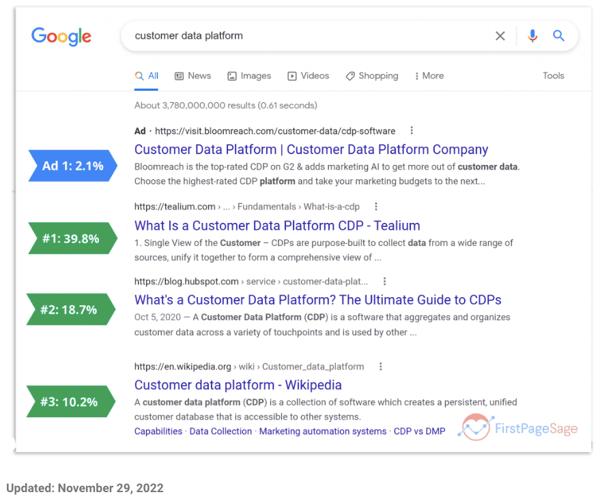Unlock SEO success: Learn how we use HubSpot Marketing Hub for SEO, boost rankings, increase organic traffic, and optimize our content for success.
How We Create SEO-Friendly Blog Posts [Video]
While SEO can initially seem daunting, it doesn't have to be. By creating and optimizing your blog post with SEO in mind, you can significantly boost the visibility of your content. In this blog, we'll dive into everything you need to know to ensure that your blog post is SEO-friendly, ensuring it ranks high on search engines.

Search engine optimization, or SEO for short, is essential to creating successful content online. It's optimizing your website or blog to rank higher in search engine results pages (SERPs), making your content more likely to be seen by people searching for topics related to your niche. For bloggers, a strong SEO strategy is crucial to build inbound links and increase traffic and lead conversions.
Conduct Keyword Research
The first step in creating an SEO-friendly blog post is researching your topic and keywords. This process involves identifying the main topic of your post and finding the most relevant keywords to target in your content.
To start, consider the audience you are writing for and the type of content they are looking for. Conducting a thorough analysis of your target audience can help you identify their needs and interests, giving you insight into the topics they are searching for online.
Once you clearly understand your audience, it's time to research keywords. This involves identifying the words and phrases people search for content related to your topic. Keyword research tools like Google Keyword Planner, Semrush, and Ahrefs can help you find the best keywords to target.
When selecting keywords, it's essential to consider each keyword's search volume and competition. Ideally, you want to choose keywords with high search volume but low competition. These keywords are more likely to help your blog post rank higher in search engine results pages.
It's also important to incorporate keywords naturally into your content. Overusing keywords, also known as "keyword stuffing," can hurt your SEO efforts and make your content less engaging to readers. Instead, aim to use keywords naturally and organically that enhance the quality of your content.
Writing Your Blog Post
Once you've identified your topic and keywords, it's time to start writing your blog post. Writing an SEO-friendly blog post involves creating high-quality content and formatting it in a way that's easy for readers and search engines to understand.
Here are some tips to get you started:
-
Use a strong headline. As it is the first thing readers will see, make your blog headline compelling and attention-grabbing. Including your target keyword in the headline can also help boost your SEO. Ideally, your headline should be between 55 and 70 characters.
-
Proper use of title/header tags (H1, H2, H3, etc.) Make sure to use one and only one <H1> title tag and have the structure of headers and subheaders aligned. Header tags help search engines understand the structure of your content; they are not formatting tools.
-
Write in short paragraphs. Long blocks of text can be overwhelming for readers, so break up your content into short paragraphs. Aim to keep your paragraphs to no more than three to four sentences; using bulleted and numbered lists to break up text on your post can also be helpful.
-
Use subheadings. Subheadings are another great way to break up your content into sections, making it easier for readers to scan and find the information they want. Including your target keyword in at least one subheading can also help boost your SEO.
-
Create engaging content. Your content should be valuable and informative to your readers. Answer common questions and provide helpful tips and advice related to your topic.
-
Use internal and external links. Including links to other pages on your website (internal links) and other relevant websites (external links) can help boost your blog's authority and improve your SEO.
-
Optimize for featured snippets. Featured snippets are short summaries at the top of search engine results pages. Optimizing your content to be featured in these snippets can help increase your visibility and drive more traffic to your blog.
-
Use your keywords strategically. While it's essential to include your target keywords in your blog post, it's also important not to overdo it. Keyword stuffing can result in penalties from search engines and make your post difficult to read. Instead, use your keywords strategically throughout your post, in the time, header tags, meta description, and within the body of the post. Aim for a keyword density of about 1-2 % for best results.
-
Use images and videos. Visuals break up your text and make it more engaging. Use high-quality images and videos that relate to your topic. Compress your images and use descriptive filenames and alt text to help search engines understand what they're about.
-
Optimize your meta description. Your meta description is the text below your headline in search engine results. It should be between 135 and 160 characters and include your primary keyword. Make sure it's compelling and accurately represents the content of your blog post.
You might also like:
Does SEO Matter?
After all of this work, you may wonder: does SEO matter? In short, yes. The whole point of inbound marketing is building organic website traffic, but that doesn't happen with no effort. SEO helps potential leads find your website through a display of experience, expertise, authoritativeness, and trustworthiness, increasing the likelihood that they convert into customers. Here's how SEO helps.
-
Content quality is still king. While SEO is important, it's not the only factor that affects search engine rankings. Content quality is still the most critical factor. You must create high-quality content that is informative, engaging, and relevant to your target audience. If your content is high-quality, people will be likelier to share it on social media and link to it from their websites. This will help to improve your website or blog's ranking in search results.
Keywords are the foundation of SEO. Identifying the most relevant keywords your target audience is searching for to optimize your website or blog for search engines is crucial. You can use various keyword research tools to help you pinpoint the right keywords for your content. By incorporating these keywords naturally and strategically, you can improve your website's ranking in search results pages and attract more organic traffic. -
Increases Organic Traffic: SEO helps to improve your website's visibility in search engine results pages, which can drive more traffic to your blog post. Optimizing your blog post for specific keywords can increase your chances of ranking higher in search engine results, leading to more organic traffic.
-
Improves User Experience: SEO isn't just about optimizing your content for search engines. It's also about making your content more user-friendly. Optimizing your blog post for SEO can make it easier for readers to find the information they're looking for, improving their overall user experience.
More than 80% of online experiences begin with a search engine. Businesses can improve their search engine rankings by making content more user-friendly and easy to find and enhancing the overall user experience. -
Builds Credibility: Ranking well in search engine results pages can help to develop your blog's credibility and authority. When people see your content appearing at the top of search engine results pages, they are more likely to see your blog as a trusted source of information in your niche.
-
About 75% of users never scroll past the first page of search results, making SEO essential for attracting more readers.
- The first page of search results receives about 95% of all clicks.
-
2023 data from firstpage.com demonstrates that ranking #1 generates a typical CTR of 39.8%.
-
That's more than double the CTR for the 2nd position, 18.7%, and nearly 4x the CTR for the 3rd position, 10.2%. It is also significantly higher than the CTR for the paid advertising position.
-

So, ranking high in search engine results boosts credibility and authority and significantly increases your chances of getting clicks and traffic.
Incorporating proper SEO techniques into your blog can skyrocket its visibility on search engine results pages by more than 200% in less than a year.
Ultimately, SEO optimization is crucial to getting your blog content to viewers. You can significantly impact your search engine rankings by tweaking your blog in small ways.










Leave a Comment